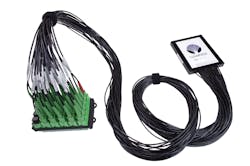Fiber everywhere requires PON components to handle everything
Over the next five years, an unprecedented era of building fiber networks will take place around the world, with passive optical networks (PON) making up a large portion of that construction. As networks are deployed in more places, and in more diverse and sometimes difficult-to-reach environments, the need to make sure the highest-quality optical components are within that network only increases. As operators look to lower operational costs to deploy, manage, and maintain network builds, PON components will be pushed out further into the fiber network.
Record freezing temperatures and continued summer highs aren’t flukes, but facts of life. Optical splitters are deployed far from the pampered environment of an air-conditioned data center, office building, or central office, into the outside plant with extreme temperatures, below grade in vaults, above grade in pedestals, in spice closures mounted on poles, hung in aerial closures, and in outdoor enclosures outside of buildings.
There will be a temptation to save a few dollars here and there by using lower-cost PON splitters. With inflation increasing network construction costs, getting a quick capital expense savings hit by purchasing cheaper splitters is tempting, but not necessarily a choice that will guarantee reliability and reduce operational costs over the lifetime of the network.
If anything, rigorously tested optical splitters have the ability to help operators save money over the long term because they are purpose built to survive environmental stresses and future upgrades for the long haul. Yesterday’s gigabit-speed standards are already moving to multi-gig speeds supported by 10G PON networks. With 25G PON networks coming into the market this year and 50G to 100G PON networks on the horizon, network operators need to anticipate the future and plan for it with the best-available components necessary to support it. And components that can migrate with your network as upgrades happen will be worth the time and effort.
Testing for the best: No shortcuts
High-quality and reliable components are backed by accreditation and certification using known testing plans, with the most trusted of them the Telcordia Generic Requirements (GR) test plan. Telcordia remains the gold standard for optical testing. There are no shortcuts. Suppliers should be able to share the certification or test data with you to verify they are able to meet GR certification.
How many ways are quality PON components tested? Operational wavelength, insertion loss, return loss, uniformity, and operating temperature are all critical factors to be compared and verified while factors such as mechanical and durability characteristics along with optical endurance are tested.
Optical wavelength—the wavelength spectrum components are designed and manufactured to work with—should always be in a full range of 1260 nm to 1650 nm. Some components could be restricted or filtered for other applications.
Insertion loss becomes extremely important, especially when calculating the overall loss budget and the ability to extend a fiber network further, reducing overall build costs. Typical connectors have a loss of 0.35dB, but quality connectors that come with lower insertion loss are what you want, with some providing a maximum insertion loss of 0.2dB per connector with a typical loss of 0.15dB. Insertion loss also comes into play when upgrading PON speeds, where less loss is the best loss.
You also need to beware that not all insertion loss claims are consistent. Manufacturers of quality splitters specify their losses as a terminated component. Some suppliers show their max loss as an unterminated component. A terminated max insertion loss of 16.8dB is not the same as an unterminated loss of 16.8dB. You want to look for components with a terminated max insertion of 16.8 dB.
Operating temperature is nothing to be trifled with when selecting PON components for use in outside plant and shouldn’t be confused with storage temperature, when the component is sitting on a shelf somewhere. A hardened outside plant component should work in temperature ranges from -40 degrees C to +85 degrees C, the range established under Telcordia GR-1209/1221 certification. From an operator perspective, this means networks that can be deployed anywhere that customers reside. The last thing you need is to have an optical splitter go out during a cold snap or heat wave and have to do a truck roll to restore service to 32 or 64 customers in miserable weather.
Blue Ridge Communications is one service provider that has watched their ruggedized splitters get tested in ways they didn’t expect. “We have over 1,000 homes connected in the mountains of Pennsylvania,” said Zac Cronauer, fiber network manager for Blue Ridge Communications. “The temperatures in the area reached sub-zero. We haven’t had one outage due to a splitter failure in two years of operation.”
The cost of low-cost isn’t cheap
As inflation and other issues are driving up capital costs, network operators are tempted to get a quick capital cost saving hit by replacing fully hardened and tested parts with lower-cost PON splitters that haven’t been certified to operate in extreme conditions. But those cost “savings” can ripple into costly operational-expense repairs and impact on bottom-line revenues depending on how many customers are affected and who they are.
If a single splitter delivering service to 32 homes fails, the short-term impact is downtime to a group of customers, plus a truck roll to diagnose and fix the issue. Depending on where the failure is and what the weather conditions are, you’re talking several hours of repair crew time plus the replacement part once you find the point of failure. A low-cost splitter may cost in the range of $300 to $400. The cost of a truck roll, plus replacement parts easily adds up to $1,000 dollars. Add in the intangible cost of the hit to your service reliability and by contrast, a fully tested ruggedized splitter looks like a bargain even at double the price of the low-cost option—around $700 or so.
On a one-time basis with residential customers in the mix, this may be bearable, but you as the service provider have taken a reputational hit because not one but a group of customers has gone down. You may have to provide some sort of discount and other compensation to get back in their good graces or you may be able to ride out the interruption as just bad luck.
However, the economics on the splitter failure shift from tolerable to poor if there are one or more business customers serviced on that PON segment. Business customers typically want, and pay for, service level agreements (SLAs) with associated penalties for unscheduled downtime because they’re paying more for their service. A business customer paying several hundred or more dollars (usually much more) per month isn’t going to put up with a multi-hour outage in the middle of the business day. They will want recompense in the short term and may start shopping around for a more reliable broadband provider in the longer term.
Let’s go further and bet that the “standard” splitter is not a one-off failure or issue, but one that needs to be replaced a number of times due to unscheduled outages. The subtle loss in dBs you were willing to put up with by fielding non-ruggedized splitters to save on front-end capital expense has turned into an operational headache costing time and money to fix across the network.
As a scientist, Benjamin Franklin knew more about electricity than optics, but he helped popularize the phrase most applicable here: “Penny wise and pound foolish.” Network construction shouldn’t be penny wise when building for the future, where short-term savings in capital construction expenses become long-term expensive headaches.
Choosing quality optical components—those that are designed and certified to industry testing standards—saves network providers significant hassle and expenses down the road. Using lower-quality optical components will cause headaches in total cost of ownership that will be exacerbated as network speeds continue to increase over the lifetime of the network.
About the Author

Michael Wood
Michael Wood is national market manager for Clearfield, focusing on utilities. He also manages the industry certification training program and advanced marketing work related to federal broadband funding programs. A Certified Fiber Optic Technician (CFOT), Michael has held positions including process engineer, fiber-optic product manager, and global product manager. He holds a Bachelor of Science degree in mechanical engineering from the University of Notre Dame.
